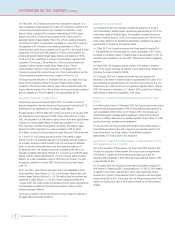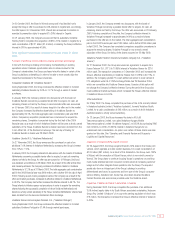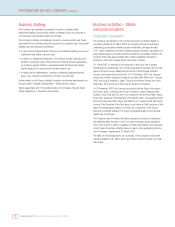Vodafone 2003 Annual Report Download - page 16
Download and view the complete annual report
Please find page 16 of the 2003 Vodafone annual report below. You can navigate through the pages in the report by either clicking on the pages listed below, or by using the keyword search tool below to find specific information within the annual report.
Vodafone Group Plc Annual Report & Accounts and Form 20-F 2003
14
INFORMATION ON THE COMPANY Continued
Australia and New Zealand
On 3 May 2002, the Group completed its purchase of the remaining 4.5%
minority interest in Vodafone Australia, as a result of which the Group’s effective
interest in its Australian operations increased from 95.5% to 100%.
Network operations in Australia and New Zealand, both of which operate under the
Vodafone brand name, increased their registered customer base by an aggregate
19% in the 2003 financial year to 3,853,000 registered venture customers at 31
March 2003. In Australia, Vodafone’s customer base increased by 418,000 net
new customers, giving a market share of over 18%, compared with 17% at 31
March 2002. In New Zealand, strong growth continued with an 18% increase in
the registered customer base to 1,289,000, resulting in a 51% market share.
Australia and New Zealand operate digital networks based on the GSM technical
standard, providing coverage to approximately 92% and 97% of the population,
respectively. At 31 March 2003, the Australian and New Zealand networks
comprised 13 and 4 MSCs and 2,276 and 866 base stations, respectively.
Australia and New Zealand have commenced plans to roll out 3G infrastructure
and expect to introduce 3G services by 2005.
India
Since 31 March 2003 the Group has entered into an agreement, subject to
conditions, to sell its entire interest in RPG Cellular Services Limited.
China
The Group has a stake in China Mobile of approximately 3.27%. The Group also
owns a 9.99% interest in Aspire Holdings Limited, China Mobile’s subsidiary set
up to develop its mobile Internet service delivery platform and take responsibility
for mobile data research and development.
At 31 March 2003, China Mobile had approximately 123,778,000 registered
customers.
Middle East and Africa
The Group’s operations and ownership interests in the Middle East and Africa
Region comprise the subsidiary company Vodafone Egypt Telecommunications
Company SAE (“Vodafone Egypt”) and two associated undertakings, Safaricom in
Kenya and Vodacom in South Africa.
Egypt
Vodafone Egypt is Egypt’s second largest mobile operator, with an estimated
market share of 48%, and operates under the brand name Vodafone. Since its
launch in November 1998, it has increased the number of customers connected
to its network to approximately 2,263,000 by 31 March 2003.
In Egypt, Vodafone offers both contract and prepaid services, with prepaid
customers representing approximately 84% of the customer base.
At 31 March 2003, Vodafone Egypt’s mobile network consisted of a GSM 900
digital network comprising 13 MSCs, 19 BSCs and 1,636 BTSs, providing
population coverage of approximately 98.5%, although providing land mass
coverage of only 12%.
South Africa
The Group has a 35% interest in Vodacom, South Africa’s largest mobile operator
with an estimated market share of 58%. Its customer base increased by 20% in
the 2003 financial year to 7,874,000 registered customers, of whom
approximately 85% are connected to the prepaid service.
Vodacom also has a licence to operate in Tanzania and, in December 2001,
formed a joint venture in the Democratic Republic of the Congo.
Mobile data services
Revenue streams from messaging data and other data services (“data revenues”)
increased 73% to £3,622 million for the 2003 financial year, and represented
over 14.6% of service revenues in the Group’s controlled subsidiaries during the
year. For the month of March 2003, data revenues as a percentage of service
revenues increased to over 15.6%, compared with 13.5% for the month of
March 2002.
Growth in data revenues has been primarily driven by the continued popularity of
SMS and benefited from the launch of a number of SMS-based products and
services by the Group during the period. The Group is also starting to generate
revenues from GPRS services. These results also include a first time contribution
from Vodafone live!, which was launched in late November 2002 although many
data services were initially offered free of charge to customers.
Further details on the Group’s strategy and plans for the development of data
services can be found in “Strategic developments – Global services”below.
Third generation licences and network infrastructure
The Group has secured 3G licences in all jurisdictions in which it operates and in
which such licences have been awarded to date. Further details can be found in
“Information on the Company – Business Overview – Business activities –
Mobile telecommunications”.
Cumulative expenditure on 3G licences was £13.5 billion at 31 March 2003 and
was funded from the Group’s existing facilities. Most of this expenditure
(£13.1 billion) occurred during the 2001 financial year. During the 2003 financial
year, the Group’s cash expenditure on intangible fixed assets was £99 million,
which included the acquisition of a 3G licence in Ireland, a further licence in
Portugal and additional GSM spectrum in Italy. Vodafone expects to participate in
additional 3G licence allocation procedures in other jurisdictions in which it
operates. No assurances can be given that the Group will be successful in
obtaining any 3G licences for which it intends to apply or bid.
The construction of 3G network infrastructure has continued throughout the
2003 financial year, with tangible fixed asset additions on 3G network
infrastructure amounting to approximately £1.7 billion. The Group presently
expects capitalised tangible fixed asset additions to be approximately £5.0 billion
in the 2004 financial year, 40% of which is expected to be in respect of 3G
network infrastructure. This expenditure is expected to be financed through
operating cash flows and existing borrowing facilities. The Group has entered into
contracts with four key suppliers for the delivery of 3G network infrastructure.
Further details on the Group’s 3G plans can be found in “Strategic developments
– Global services”below.
Strategic developments – Global services
The Group’s vision is to be the world’s mobile communications leader. A major
focus of the Group’s strategy is to offer innovative services within Vodafone-
branded, end-to-end customer propositions, which utilise the Group’s global
footprint and global brand to offer customers a unique mobile experience and
seamless international services.
These programmes, such as Vodafone live!, are based on compelling customer
propositions and have been packaged together for a specific target market.
Vodafone live! is an easy-to-use consumer service, bringing customers a world
of colour, sound and pictures, enabling them to use picture messaging, download
polyphonic ringtones and colour games, and browse branded infotainment from
integrated camera phones through an easy to use icon driven menu.
























